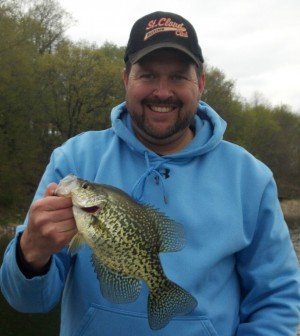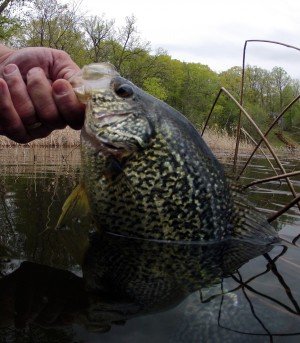Spring Time Panfish
My favorite time of year is quickly approaching. The time when the Red Wing Black Birds start arriving, when the call of the Loon greets my morning, and the chill of the crisp morning air hits my face as I launch the boat on to one of my favorite crappie waters.
YES, I love chasing springtime crappies! Typically they are eager to bite if you put in the time to pattern them at this time of year. I usually start my open water fishing within 3-4 days of the ice melting off my favorite lakes.
Shallow, dark bottom bays will attract the ‘bugs’ and minnows…and the crappies and ‘gils will follow as they are interested in putting on the feedbag before the spawn.
A few people have the misconception that the fish are spawning during this early period, because when they clean the fish the females are full of spawn. This is untrue. Panfish in our region won’t spawn until that water temp is in the mid to upper-60’s. The early ice out period is clearly about one thing. They are after FOOD!
If you’re uncertain where to start your search, look for other boats and people fishing from shore. A good rule of thumb is any shallow-dark water bay on the northern end of your favorite lake. Water temps will be the warmest there, producing bug hatches, hence the food source and their prey…black crappies.
Roughly 10 years ago my friend Duane Osgood changed the way I approach springtime panfishing. As with most of you, I almost always fished with a jig/minnow casting below a slip float. Now this method will catch fish, no doubt, but there is a more useful method in my opinion that doesn’t involve minnows or waxies for bait and I would put this tactic up against everything else day in, day out during this cold water pre-spawn pattern. It’s a simple rig, yet a few specialized tools are required. The rod/reel combo isn’t’ what you typically would see.
You start with a 9 1/2’ to 12’ Ultra Light (noodle rod). Shorter rods will work but the longer rods will aid in the casting distance, I use a Gander Mountain Guide Series, and your favorite spinning reel spooled with your favorite 4lb mono line. Mono line provides a bit of a shock absorber due to its stretch for landing the soft mouthed slab crappies. The long, ultra light
rod provides you with the ability to cast light lures a greater distance…keeping off these shallow fish, which tend to be spooky at times. As well, the ability to pick up slack line real quick on a hook set. The fight you get out of these long, limber rods is second to none.
We would start with a common 1/64oz Lindy “Little Nipper” or Flu-Flu style jig and a super sensitive pencil style bobber. If it’s windy out, we switch to a ‘rocket bobber.’ Both bobbers’ I use tip up at the slightest tap. Now depending on the depth of the water, I’ll set my depth anywhere from 18” to upwards of 5’ or so (another advantage of a long rod). That’s it…no bait.
Cast out as far as you can and slowly reel it in. Sometimes you pause, or ‘twitch’ the rod to give it a little different action, but most of the time it is just a SLOW, steady retrieve.
We would tend to search thru several packages of lures at the store, as we wanted the ones with the longest feathers possible. In our opinion, this would keep a lot of the smaller ‘gills away and provides a bit of a slower fall.
When you get the lures, we almost always take them out of the package and dab a tiny bit of super-glue on the thread, along with taking a small pliers and opening up the hook gap and off-setting it a tad. Adding super-glue would keep the feathers on the jig a lot longer. And opening up the hook gap and giving it an offset I feel improves my hooking percentage.
In the last 4 to 5 years, I have found another lure that hands-down is the best panfish jig I have ever fished. It’s a small hair jig made by a local Minnesotan. What I really LOVE about this hair jig is it’s size, durability and color combinations.
This particular jig is made with cow tail, and not feathers. The hair makes this jig come to life even when sitting perfectly still!
Some of my personal favorite colors are: Pink/Chartreuse, Blue/Chartreuse, White/Chartreuse and Orange/White. Standard size’s are in 1/100oz, 1/80oz, 1/64oz and 1/32oz. Day in, day out I will fish either the 1/100oz or 1/80oz the majority of the time. This jig falls very slow and often makes the neutral to negative spring fish bite when nothing else will. Tie them directly on with a Palomar knot—you want the lure to hang horizontal at all times to best imitate the forage they are after.
The next key is your approach. STEALTH. I will always cut the big engine off quite a ways from where I anticipate the schools of crappies to be. Entering the area instead with my bow mount trolling motor. A good pair of Polarized sunglasses can help with your visual search too, if the water is clear enough.
I’m usually fishing with someone so we start with different color jigs and different depth settings until we can establish a pattern. Once we locate a few fish, I will SLOWLY and QUIETLY ease my anchor into the water. I try to make as little noise as possible at all times. Shallow fish tend to be pretty spooky.
I will work the area fan casting until a move is required. Then repeat the process. Myself, I always like early morning fishing. I’m almost always the first one at the access. However, sometimes the bite won’t turn on until the water gets a little warmer temperature from the warming sun, and this could mean the evening. You just have to get out when you can and try for yourself.
To me there are 3 phases of spring panfishing that occur here in my home state of Minnesota. Regionally they happen at various different times due to the weather, so depending on where your fishing you have to be able to recognize what particular phase you’re fishing in and adapt your presentation to fit those conditions.
Typically when ice out occurs in the shallow bays and channels of your favorite panfish waters, ice may still be on the main body of the lake. The water temperature is in the real low 40s during the day and will warm only slightly a degree or two during the entire day. During this phase, the first panfish are starting to show up in the shallows looking for food, warmer water, and better oxygen levels within the water.
Some of the first few hardcore anglers’ start to show up at the public accesses and along the shores to kick off the open water season. This is a period of time where the fish are in a negative to neutral mood. This is a time where “T.H.E. JIG” really shines because of its slow fall rate in the water column. Over the years, I have caught some of my largest panfish, particularly crappies during this phase.
The second phase, to me, is the longest phase of spring panfishing lasting typically 3 weeks or more in most regions. The water is warming from the upper 40s to mid 50s and green weeds are starting to grow towards the surface in the shallow bays. By now, the public accesses are busy with activity. The ‘word is out’ so to speak about the fish biting.
The fish are in a neutral to aggressive mood depending on weather and now fishing pressure. This is where using a good pair of polarized glasses and the long poles I mentioned really help me put more fish in the boat than any other time. No matter how quiet you try to be, your boat still makes noise and causes a disturbance in the shallow water that the fish can sense with their lateral line. Not to mention if it’s sunny, and how your boat and yourself, if your standing, can cast a shadow onto the water and spook catchable fish!
With the long poles I can stay way off of the fish that are staged in the shallows and still be able to reach them with a long cast.
The third and final phase to me is leading right into the actual spawn and when the fish are on beds. Shallow or “skinny water” is where the pencil weeds and cattails are and where those slabs look to make nests..
A lot of angler’s, myself included have now switched gears and started to fish walleye, pike, and bass here in my home state. The water temperatures range from the upper 50s to mid 60s and the panfish are searching out their spawning grounds. The fish are again in a neutral to aggressive (protect the nest) mood. I use my polarized glasses to locate the beds and the fish. I then use the long poles here to ‘dabble’ my lure right on the bed the fish are on. If I don’t see any fish, I don’t even bother fishing the spot. They are either their, or they are not. It’s that simple. A key is to cover water while chasing these nomadic feeders.
If your favorite body of water has extensive pencil weed flats—look there for the fish to start bedding. Better yet, if these pencil weed beds are very near to where you have been catching the crappie’s weeks prior. Just dropping your jig in beds, pockets and wait for a strike. Or the use of a small slip float and a jig tipped with a minnow or small leech for ‘gills. I prefer to tip with minnows at this time because I’m leaving my lure in one place for as long as I can, and waiting for the fish to find it. The long rod is now used to lift the fish almost straight up and into the boat out of the reeds.
During this time, it’s real easy to tell the males from the females. The males will be very dark compared to the females. The females will be full of spawn and fat in the belly. I always try to use a selective harvest method during this time, keeping only a few males for a meal.
I hope some of these tips and tactics will improve your spring panfishing adventures. It’s a great time to get kids both young and old out on the water and when you hit it right, the action can be non-stop.
(Written by Travis Sorokie)

